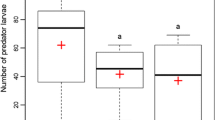Abstract
The bark beetleIps pini (Say) displays variation in its response to and production of enantiomeric blends of its pheromone ipsdienol. One of the principal predators ofIps pini isThanasimus dubius (F.), which uses ipsdienol as a kairomone for prey location. During 1988 and 1989, in Wisconsin and Michigan, the response of both species to a range of enantiomeric blends of ipsdienol was investigated. Blends tested had the following ratios of the (S)-(+) to (R)-(−) enantiomers: 3%∶97%, 25%∶75%, 50%∶50%, 75%∶ 25%, and 97%∶ 3%. Either 75% (+)∶25% (−) or 50% (+)∶50% (−) ipsdienol captured the mostIps pini in both years at both sites. The 25% (+)∶75% (−) blend also caught moreIps pini than the control during both years at both sites. All blends tested were attractive toThanasimus dubius in both years at both locations. Blend preferences of both species were variable and labile at both sites. Response patterns of both species in Wisconsin were different from those in Michigan each year. Furthermore, response patterns of both species to the ipsdienol blends changed from 1988 to 1989 at both locations. A genetic component to this variation would permit predator-prey coevolution, as well as the development of resistance byIps pini to management strategies based on mass-trapping with single blends.
Similar content being viewed by others
References
Bakke, A. 1982. Mass trapping of the spruce bark beetleIps typographus in Norway as part of an integrated control program, Vol. 2, pp. 17–25,in A.F. Kydonieus, M. Beroza, and G. Zweig (eds.). Insect Suppression with Controlled Release Pheromone Systems. CRC Press, Boca Raton, Florida.
Bakke, A. 1989. The recentIps typographus outbreak in Norway-experiences from a control program.Hoarc. Ecol. 12:515–519.
Bakke, A., andKvamme, T. 1981. Kairomone response inThanasimus predators to pheromone components ofIps typographus.J. Chem. Ecol. 7:305–312.
Billings, R.F., andCameron, R.S. 1984. Kairomonal responses of Coleoptera,Monochamus titillator (Cerambycidae).Thanasimus dubius (Cleridae), andTemnochila virescens (Trogositidae), to behavioral chemicals of southern pine bark beetles (Coleoptera: Scolytidae).Environ. Entomol. 13:1542–1548.
Birch, M.C. 1978. Chemical communication in pine bark beetles.Am. Sci. 66:409–419.
Birch, M.C., Light, D.M., Wood, D.L., Browne, L.E., Silverstein, R.M., Bergot, B.J., Ohloff, G., West, J.R., andYoung, J.C. 1980. Pheromonal attraction and allomonal interruption ofIps pini in California by the two enantiomers of ipsdienol.J. Chem. Ecol. 6:703–717.
Borden, J.H. 1982. Aggregation pheromones, pp. 74–139,In J.B. Mitton and K.B. Sturgeon (eds.). Bark Beetles in North American Conifers: A System for the Study of Evolutionary Biology. University of Texas Press, Austin.
Borden, J.H., Hunt, D.W.A., Miller, D.R., andSlessor, K.N. 1986. Orientation in forest Coleoptera: An uncertain outcome of responses by individual beetles to variable stimuli, pp. 97–109,in T.L. Payne, M.C. Birch, and C.E.J. Kennedy (eds.). Mechanisms in Insect Olfaction. Clarendon Press, Oxford.
Hansen, K. 1983. Reception of bark beetle pheromone in the predaceous clerid beetle,Thanasimus dubius (Coleoptera: Cleridae).J. Comp. Physiol. 150:371–378.
Janzen, D.H. 1980. When is it coevolution?Evolution 34:611–612.
Lindgren, B.S. 1983. A multiple funnel trap for scolytid beetles (Coleoptera: Scolytidae).Can. Entomol. 115:299–302.
Lanier, G.N., Birch, M.C., Schmitz, R.F., andFurniss, M.M. 1972. Pheromones ofIps pini (Coleoptera: Scolytidae): Variation in response among three populations.Can. Entomol. 104:1917–1923.
Lanier, G.N., Classon, A., Stewart, J.J., Piston, J.J., andSilverstein, R.M. 1980.Ips pini: The basis for interpopulational differences in pheromone biology.J. Chem. Ecol. 6:677–687.
Miller, D.R., Borden, J.H., andSlessor, K.N. 1989. Inter- and intrapopulation variation of the pheromone, ipsdienol produced by male pine engravers,Ips pini (Say) (Coleoptera: Scolytidae).J. Chem. Ecol. 15:233–247.
Mizell, R.F., III, Frazier, J.L., andNebeker, T.E. 1982. Response of the clerid predatorThanasimus dubius (F.) to bark beetle pheromones and tree volatiles in a wind tunnel.J. Chem. Ecol. 10:177–187.
Payne, T.L., Dickens, J.C., andRicherson, J.V. 1984. Insect predator-prey coevolution via enantiomeric specificity in a kairomone-pheromone system.J. Chem. Ecol. 10:487–492.
Piston, J.J., andLanier, G.N. 1974. Pheromones ofIps pini (Coleoptera: Scolytidae), response to interpopulational hybrids and relative attractiveness of males boring in two host species.Can. Entomol. 106:247–251.
Price, P.W. 1981. Semiochemicals in evolutionary time, pp. 251–279,in D.A. Nordlund, R.L. Jones, and W.J. Lewis (eds.).Semiochemicals: Their Role in Pest Control. Wiley, New York.
Raffa, K.F., andKlepzig, K.D. 1989. Chiral escape of bark beetles from predators responding to a bark beetle pheromone.Oecologia 80:566–569.
SAS Institute. 1988. SAS/STAT User's Guide. Release 6.03. SAS Institute, Cary, North Carolina.
Schenk, J.A., andBenjamin, D.M. 1969. Notes on the biology ofIps pini in central Wisconsin jack pine forests.Ann. Entomol. Soc. Am. 62:480–485.
Slessor, K.N., King, G.G.S., Miller, D.R., Winston, M.L., andCutforth, T.L. 1985. Determination of chirality of alcohol or latent alcohol Semiochemicals in individual insects.J. Chem. Ecol. 11:1659–1666.
Vité, J.P., andWilliamson, D.L. 1970.Thanasimus dubius: Prey perception.J. Insect. Physiol. 16:233–239.
Vité, J.P., Bakke, A. andJ.A.A. Renwick, 1972. Pheromones inIps (Coleoptera: Scolytidae): Occurrence and production.Can. Entomol. 104:1967–1975.
Wood, D.L. 1982. The role of pheromones, kairomones, and allomones in the host selection and colonization behavior of bark beetles.Annu. Rev. Entomol. 27:411–446.
Author information
Authors and Affiliations
Additional information
Editor's Note: This paper originally appearedin Journal of Chemical Ecology, Volume 17, Number 3 (March 1991), pp. 515–524. Due to several significant printer's errors, the paper is reprinted here in entirety in its corrected form.
Rights and permissions
About this article
Cite this article
Herms, D.A., Haack, R.A. & Ayres, B.D. Variation in semiochemical-mediated prey-predator interaction:Ips pini (Scolytidae) andThanasimus dubius (Cleridae). J Chem Ecol 17, 1705–1714 (1991). https://doi.org/10.1007/BF00984698
Received:
Accepted:
Issue Date:
DOI: https://doi.org/10.1007/BF00984698




